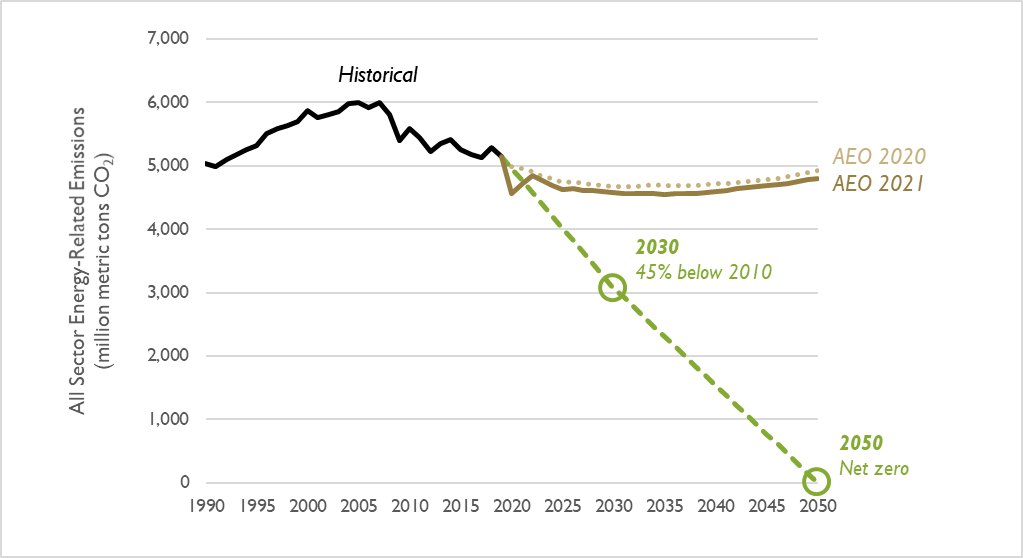Latest Annual Energy Outlook Shows Less Coal, More Renewables—but Still a Colossal Gap on Emissions Targets
On February 3, 2021, the U.S. Energy Information Administration (EIA) released the 2021 Annual Energy Outlook (AEO). AEO 2021 contains projections of energy use from the electric power, residential, commercial, industrial, and transportation sectors through 2050. AEO 2021’s Reference case is a projection of the future based on estimates of fuel availability, changes in technology costs, and current legislation.
Electric-sector CO2 emissions are projected to substantially decrease, relative to AEO 2020
Compared to last year’s AEO projection, electric sector carbon dioxide (CO2) emissions are 2 percent lower in AEO 2021, when looking at the entirety of CO2 emitted between 2020 (which is a modeled year in both AEOs, as actual data is not yet aggregated) and 2030 (Figure 1). This is a smaller decrease than observed between the previous two AEO projections (which featured a 15 percent difference in electric sector CO2 emissions over this same period). However, AEO 2021 models lower emissions into the future: over the 2020–2050 period, AEO 2021’s electric sector CO2 emissions are 6 percent lower than was modeled in AEO 2020.
Figure 1. Comparison of electric-sector CO2 emission projections in the AEO 2021 and 2020 Reference case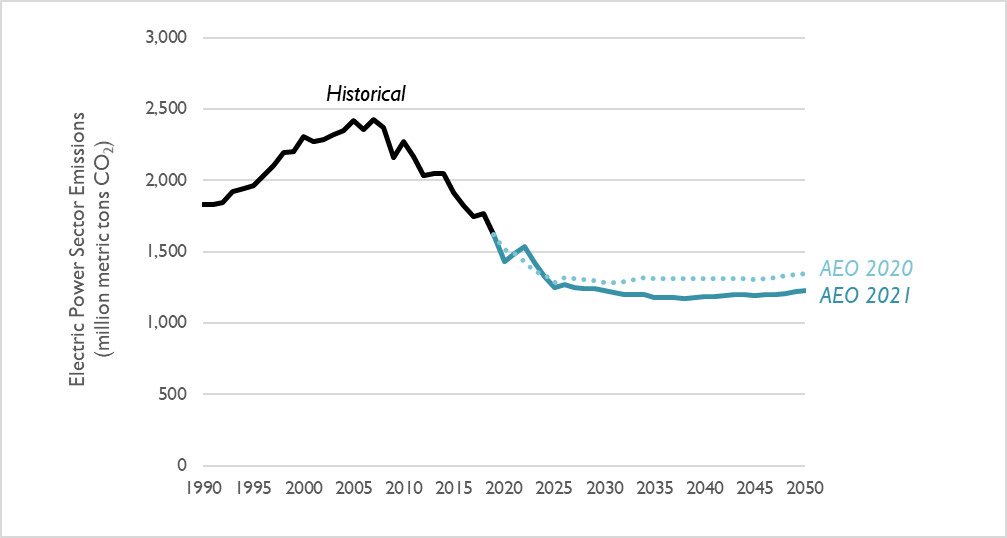
Lower emissions are due to an increasingly clean electricity sector
In AEO 2021, EIA projects an increase in generation from wind and solar, a decrease in coal generation, and a flattening of natural gas generation (see Figure 2). However, most of the interesting departures from AEO 2020 do not occur until the mid-2020s.
- Natural gas: In the near term, EIA projects lower levels of natural gas generation in AEO 2021 than in AEO 2020. Gas generation peaks in 2020 (a modeled year), falls by 13 percent the following year, and then rebounds to recent historical levels by the mid-2020s. Nationwide, gas generation is not projected to increase above today’s levels until the mid-2030s.
- Coal: EIA’s latest near-term projection of coal generation is very different than in AEO 2020. AEO 2021 projects that coal generation in 2020 was 20 percent lower than in the previous year. However, AEO 2021 then projects that this generation will rebound to 2019 levels for a few years before falling again in 2023. Coal generation then falls by about 1 percent per year every year through 2050.
- Wind and solar: AEO 2021 projects very similar near-term growth trends in wind and solar, compared to the previous projection: wind and solar are both expected to roughly double in generation between 2020 and 2025. However, the trends differ in the out-years. EIA is projecting solar to follow a similar trend as was modeled in the last AEO through 2030, slow down in its rate of increase in the mid-2030s, then pick back up again in the early 2040s. Meanwhile, EIA is projecting that wind generation slows down substantially after the mid-2020s, reflecting the modeled impacts of the production tax credit’s phase-out.
As in AEO 2020, AEO 2021 projects that wind and solar generation (combined) is expected to exceed coal generation in 2024.
Figure 2. Comparison of electricity generation from coal, natural gas, and wind and solar in the AEO 2021 and AEO 2020 Reference cases (series from AEO 2020 are shown as dotted lines) 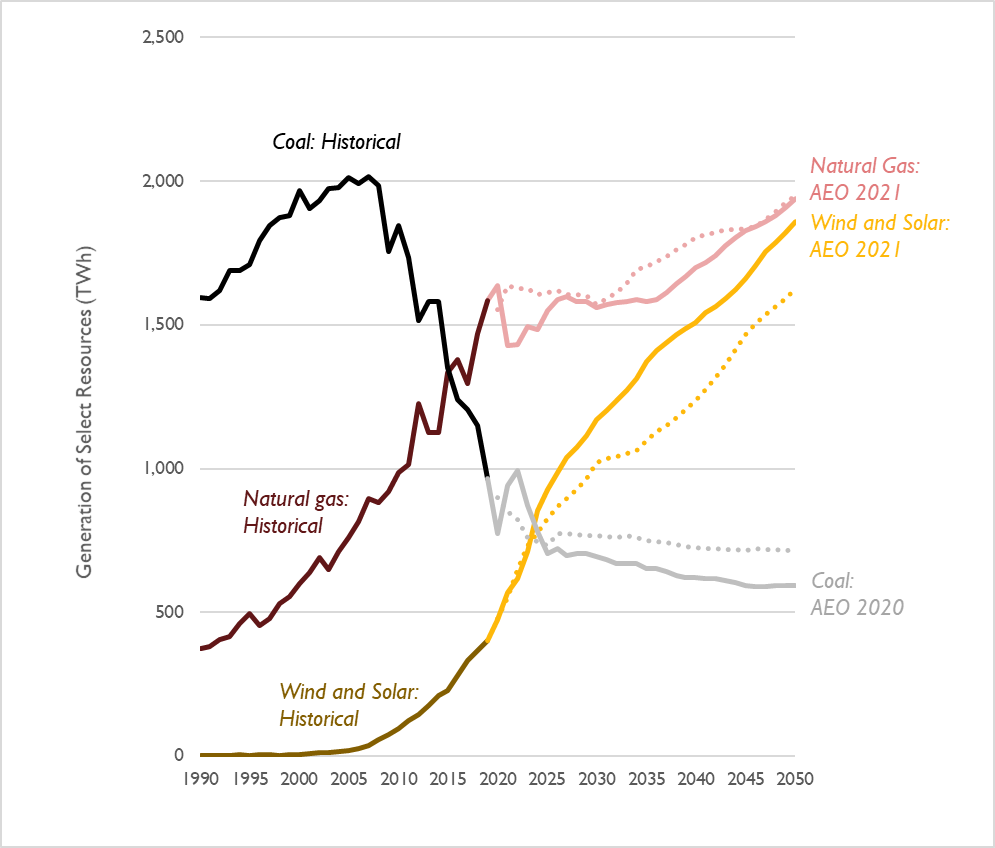
Note: Generation from hydro, nuclear, geothermal, biomass, and miscellaneous sources are not included in this figure.
The shifts in natural gas and coal generation are driven in part by the dynamics of the latest AEO’s natural gas price projection (see Figure 3). Compared to AEO 2020, AEO 2021 projects higher gas prices in the early 2020s. From 2025 through 2050, the projections of gas prices are very similar. These dynamics (higher prices in the near term, but sustained low prices overall) help drive higher coal generation in the near term, but contribute to almost 100 GW of coal retirements by 2030 (equivalent to 45 percent of present-day coal capacity).
Figure 3. Comparison of natural gas prices at the Henry Hub in the AEO 2021 and AEO 2020 Reference cases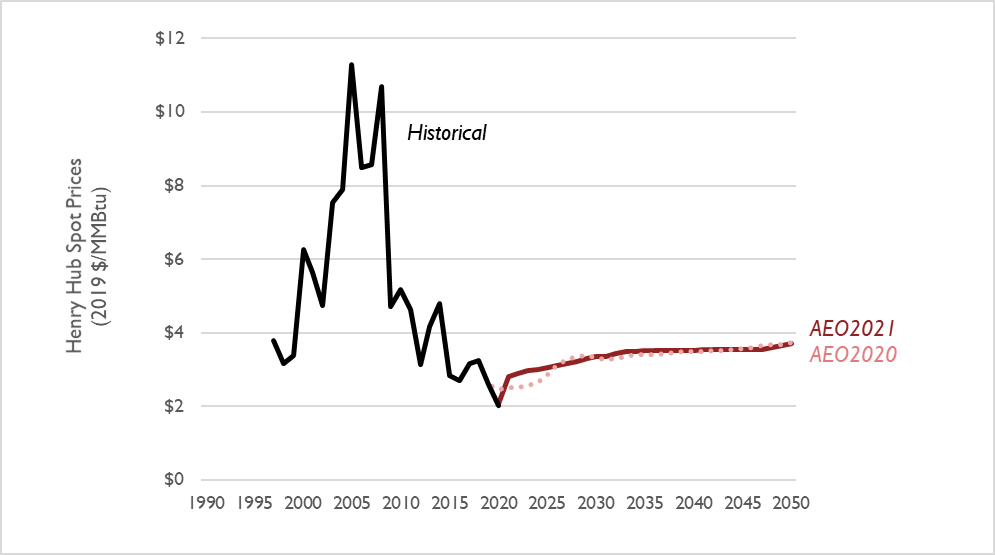
Aggregated electricity generation from coal, natural gas, renewables, and other resources in AEO 2021 are virtually unchanged compared to last year’s projection. This is because EIA has not significantly revised its projection for electricity sales, except for some minor changes in the very near term due to economic slowdown resulting from the COVID-19 pandemic (see Figure 4). Between 2020 and 2030, projected electricity sales are, on average, 1 percent lower per year relative to AEO 2020. However, because sales are still increasing, by 2030, total electricity sales are 9 percent higher than today.
Figure 4. Comparison of electricity sales projections in the AEO 2021 and AEO 2020 Reference cases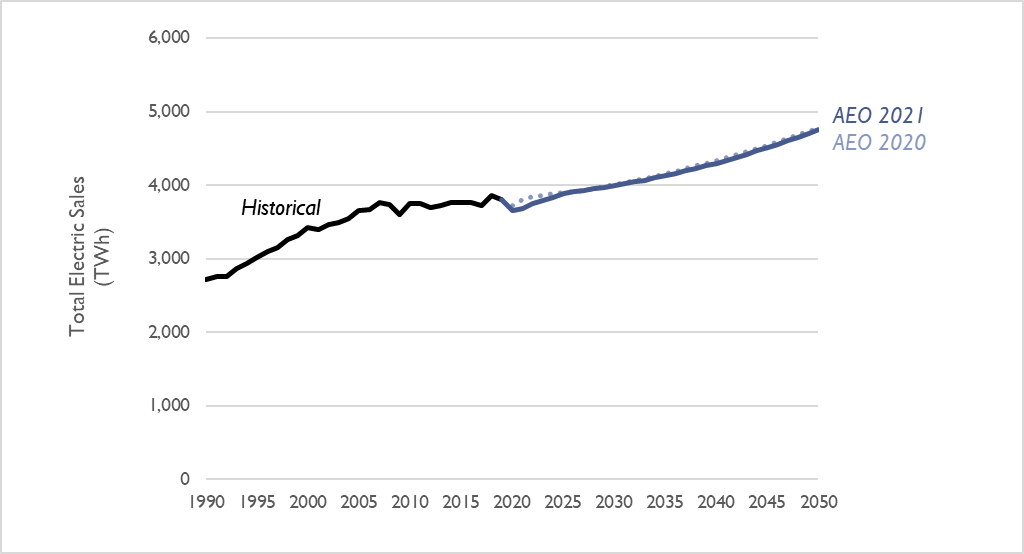
EIA projects a reduced share of electric vehicles through 2050
Compared to AEO 2020, AEO 2021 projects a 4 percent decrease in number of the vehicles on the road in 2030, which grows to a 6 percent spread in 2050. Echoing a trend from previous years, AEO 2021 models that light-duty vehicles are increasingly “light trucks” rather than “cars.” However, the differences between these two categories are becoming increasingly blurred, with the majority of both categories being made up by crossover vehicles of various sizes by 2030.Perhaps the most interesting trend in AEO’s latest modeling are the small number of electric vehicles (EV) on the road in future years. EIA’s projection of the share of vehicles that are electric has actually decreased, relative to AEO 2020. In 2050, plug-in hybrids and battery EVs make up 8 percent of all vehicles, down from 10 percent in the previous AEO. In 2035, AEO 2021 assumes that these vehicles make up about 8 percent of all vehicle shares. 2035 is a critical year for EV sales: conventional vehicles may no longer be sold in California and other states after that year, and several automakers including General Motors have indicated that they will no longer sell conventionally fueled vehicles by that date.
Figure 5. Light-duty vehicle stock in the AEO 2021 and 2020 Reference cases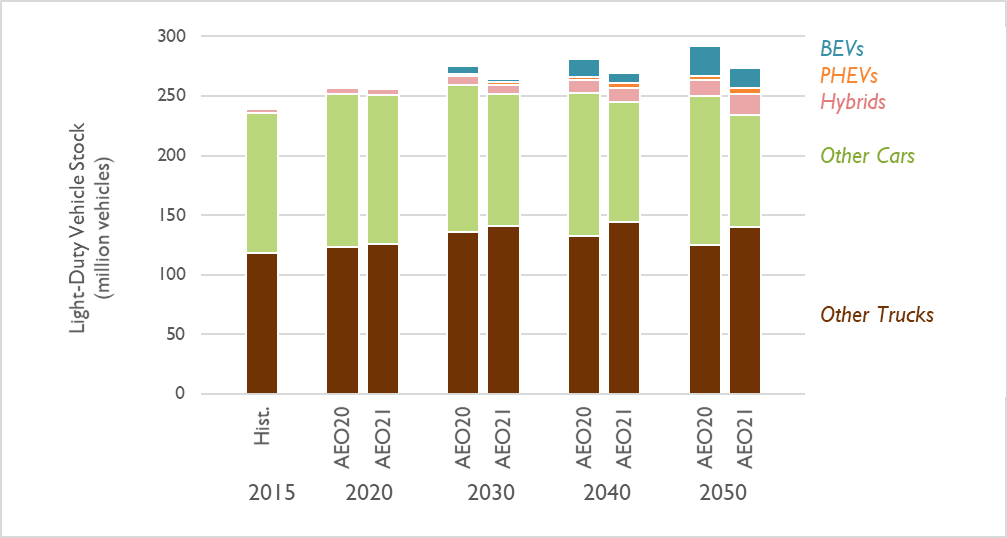
Note: BEVs includes all-electric vehicles. PHEVs includes plug-in hybrids, while Hybrids constitutes non-plug-in hybrids. All other alternative light-duty vehicles are included in Other Cars and Other Trucks.
Emissions from all sectors continue to exceed the limit needed to avert catastrophic climate change. According to the Intergovernmental Panel on Climate Change (IPCC), economy-wide greenhouse gas emissions must decrease by 45 percent by 2030 and be eliminated altogether by 2050 to avert catastrophic climate change. The AEO 2021 Reference case features a steep decrease in emissions in 2020—as a result of the economic slowdown from the COVID-19 pandemic—but projects a rapid return to the AEO 2020 trajectory soon afterwards. In 2050, AEO 2021 projects emissions will be 4 times higher than what is recommended by climate scientists (see Figure 6).
Figure 6. Comparison of all-sector CO2 emission projections in the AEO 2021 and 2020 Reference cases, relative to the level needed to avert catastrophic climate change (shown on this chart as a dashed line)